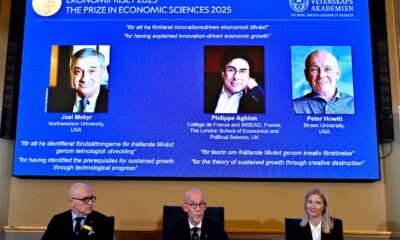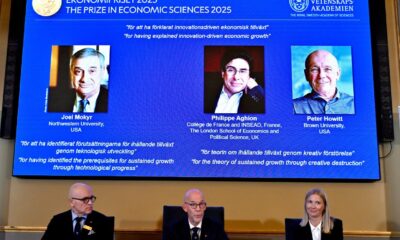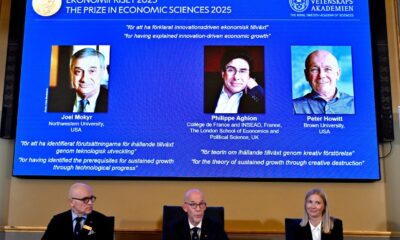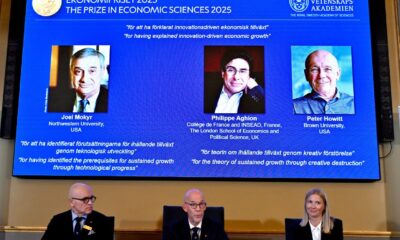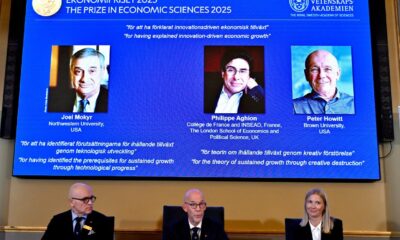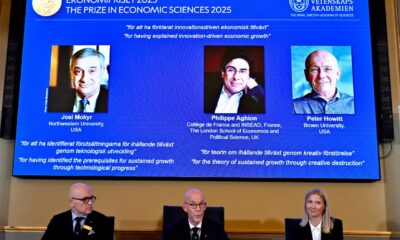Science
Economists Win Nobel Prize for Insights on Creative Destruction
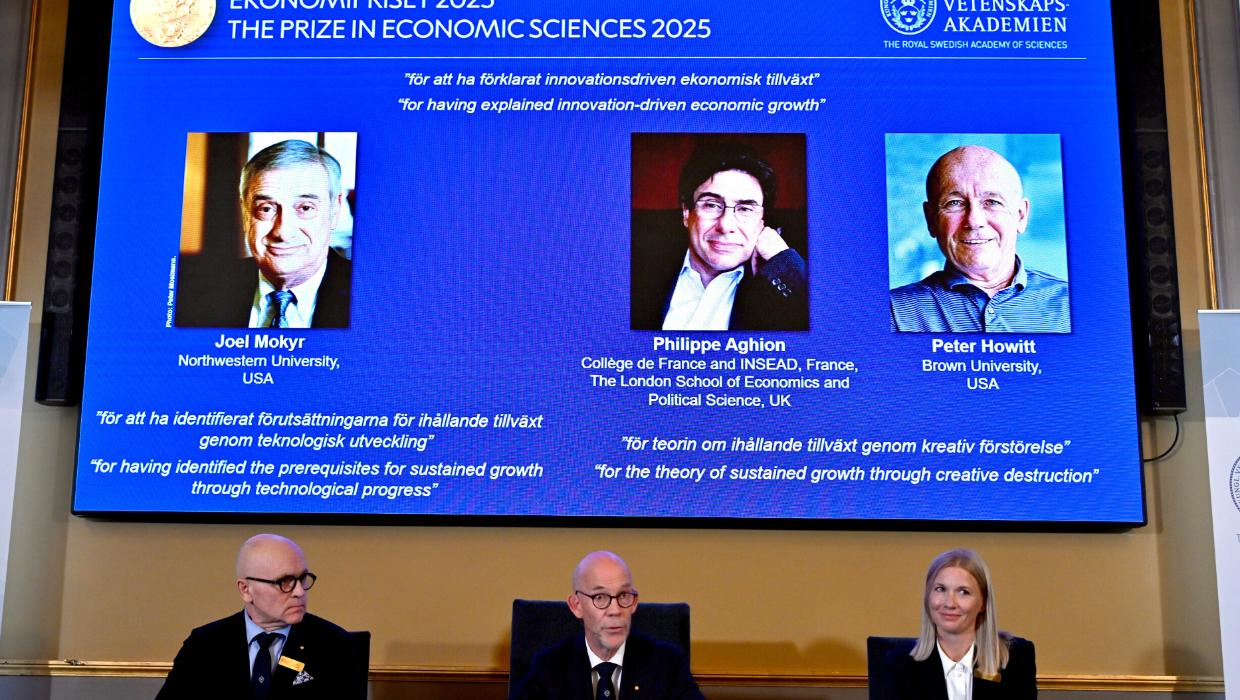
Three economists were awarded the Nobel Memorial Prize in Economic Sciences on March 12, 2024, for their significant contributions to understanding the concept of “creative destruction.” This term describes how innovation and new technologies can replace older businesses and technologies, often with profound effects on economic growth and human welfare. The award recognizes the work of Dutch-born Joel Mokyr, 79, from Northwestern University; Philippe Aghion, 69, affiliated with Collège de France and the London School of Economics; and Canadian-born Peter Howitt, 79, from Brown University.
The Nobel Committee highlighted how these researchers have enhanced the understanding of creative destruction, a concept first introduced by economist Joseph Schumpeter in his 1942 work, “Capitalism, Socialism and Democracy.” Schumpeter referred to creative destruction as “the essential fact about capitalism.” The committee remarked that Mokyr’s work illustrates the necessity of not only recognizing successful innovations but also understanding the scientific reasoning behind them.
Understanding Creative Destruction
The laureates’ research focuses on how new innovations replace outdated technologies, a phenomenon evident throughout history. From steam locomotives rendering horse-drawn wagons obsolete to the rise of e-commerce disrupting traditional retail, the process of creative destruction has continually reshaped economies. Examples include streaming services replacing video rental businesses and internet advertising overshadowing print media.
The Nobel Committee noted that “economic growth cannot be taken for granted.” John Hassler, chair of the committee, emphasized the need to support the mechanisms that underpin creative destruction to avoid economic stagnation. Aghion and Howitt’s complex mathematical model from 1992 provided deeper insights into the mechanisms of sustained growth, identifying how markets with limited competition can stifle innovation.
Their findings highlight the importance of aiding individuals affected by technological changes, advocating for policies that prioritize worker mobility over job preservation. The economists stress the necessity of social mobility, ensuring that a person’s profession is not predetermined by their family background.
The Future of Innovation
Mokyr, recognized as an optimist regarding technological advancement, countered the pessimistic views held by some economists who argue that recent innovations lack the economic impact of earlier inventions. He pointed out that new services, often inexpensive or free, provide substantial benefits that may not be immediately reflected in economic data. In a 2015 interview, he cited the music streaming service Spotify as an example of an innovation that is difficult to quantify but has transformed access to music.
Aghion emphasized the challenge Europe faces in keeping pace with the innovation rates of the United States and China. He stated that to remain competitive, Europe must promote research and venture capital to translate ideas into viable businesses. He remarked, “We have to wake up. Because you know who will win in this competition? Those who innovate.”
The potential impact of artificial intelligence (AI) was also a focal point of the laureates’ discussions. Aghion acknowledged AI’s significant growth potential while stressing the importance of institutional and policy frameworks to foster competition. He dismissed fears of AI leading to human extinction, describing it instead as a valuable tool to enhance productivity and research.
Mokyr shared his surprise at receiving the Nobel Prize, recounting how he learned of the honor early in the morning with a flurry of congratulatory messages. He reflected on his lifelong passion for his work, stating, “This is the type of job that I dreamed about my entire life.” Howitt similarly expressed his astonishment, initially mistaking the call from a Swedish journalist as a prank. Aghion noted the challenge of coordinating with his co-winners due to the committee lacking their contact information, highlighting the camaraderie among the trio.
The Nobel Prize in Economic Sciences, formally known as the Bank of Sweden Prize in Economic Sciences in Memory of Alfred Nobel, comes with an award of 11 million Swedish kronor (approximately $2.02 million). Mokyr will receive half of the prize, while Aghion and Howitt will share the other half. Alongside the monetary award, recipients also receive an 18-carat gold medal and a diploma.
Since its establishment in 1968, the economics prize has been awarded 57 times to a total of 99 laureates, with only three women among the recipients. Nobel purists note that while the economics prize is not technically a Nobel Prize, it is presented alongside the original Nobel Prizes each year on December 10, commemorating Alfred Nobel’s death in 1896.
-

 World6 days ago
World6 days agoPrivate Funeral Held for Dean Field and His Three Children
-

 Top Stories1 week ago
Top Stories1 week agoFuneral Planned for Field Siblings After Tragic House Fire
-

 Sports3 months ago
Sports3 months agoNetball New Zealand Stands Down Dame Noeline Taurua for Series
-

 Entertainment3 months ago
Entertainment3 months agoTributes Pour In for Lachlan Rofe, Reality Star, Dead at 47
-

 Entertainment2 months ago
Entertainment2 months agoNew ‘Maverick’ Chaser Joins Beat the Chasers Season Finale
-

 Sports3 months ago
Sports3 months agoSilver Ferns Legend Laura Langman Criticizes Team’s Attitude
-

 Sports4 weeks ago
Sports4 weeks agoEli Katoa Rushed to Hospital After Sideline Incident During Match
-

 Politics2 months ago
Politics2 months agoNetball NZ Calls for Respect Amid Dame Taurua’s Standoff
-

 World2 weeks ago
World2 weeks agoInvestigation Underway in Tragic Sanson House Fire Involving Family
-

 Entertainment3 months ago
Entertainment3 months agoKhloe Kardashian Embraces Innovative Stem Cell Therapy in Mexico
-

 Sports4 weeks ago
Sports4 weeks agoJamie Melham Triumphs Over Husband Ben in Melbourne Cup Victory
-

 World4 months ago
World4 months agoPolice Arrest Multiple Individuals During Funeral for Zain Taikato-Fox

